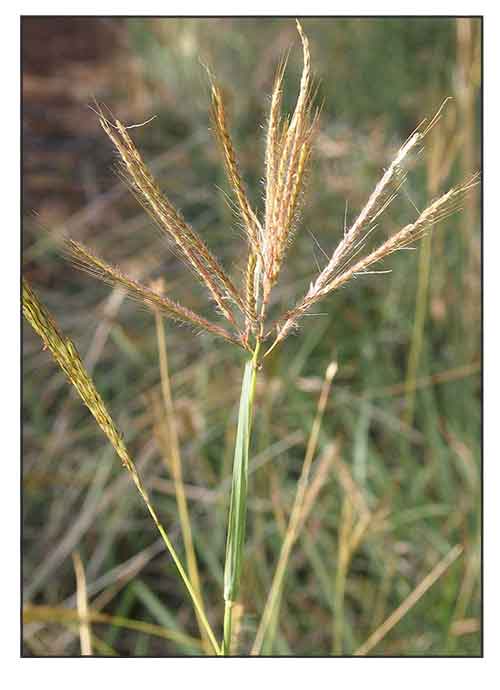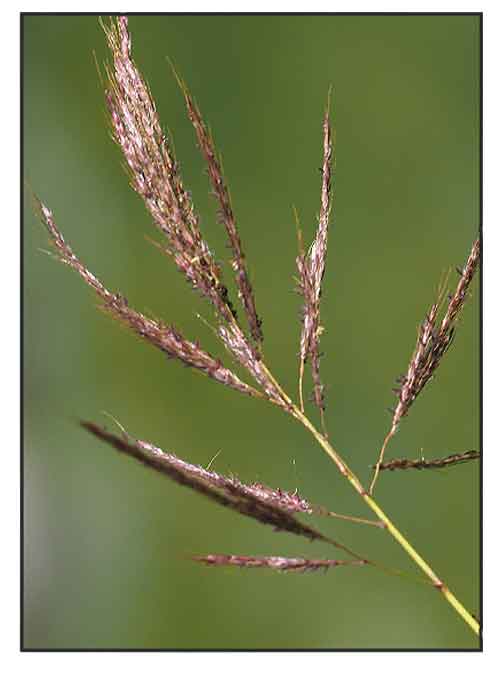
Family • Poaceae
Bladhi bluegrass
Bothriochloa bladhii (Retz.) S.T.Blake
AUSTRALIAN BLUESTEM / FOREST BLUEGRASS / PURPLE PLUME GRASS
Chou gen zi cao
| Scientific names | Common names |
| Amphilophis glabra var. haenkei (J.Presl) E.G.Camus & A.Camus | Australian beardgrass (Engl.) |
| Amphilophis haenkei (J.Presl) Haines | Australian bluestem (Engl.) |
| Amphilophis insculpta var. vegetior (Hack.) Stapf | Caucasian bluestem (Engl.) |
| Amphilophis intermedia (R.Br.) Stapf | Forest blugrass (Engl.) |
| Amphilophis intermedia var. acidula (Stapf) Stapf | Plain bluestem (Engl.) |
| Amphilophis odorata (Lisboa) A.Camus | Purple plume grass (Engl.) |
| Amphilophis intermedia (R.Br.) Stapf | |
| Anatherum montanum (Roxb.) Schult. | |
| Andropogon annulatus var. bladhii (Retz.) Hack. | |
| Andropogon bladhii Retz. | |
| Andropogon caucasicus Trin. | |
| Andropogon haenkei J.Presl | |
| Andropogon intermedius R.Br. . . . | |
| Andropogon inundatus  F.Muell. | |
| Andropogon lephanthus Steud. | |
| Andropogon montanus Roxb. | |
| Andropogon odoratus Lisboa | |
| Andropogon perfossus Nees & Meyen ex Steud. | |
| Andropogon pertusus var. vegetior Hack. | |
| Andropogon punctatus Roxb. | |
| Andropogon vachellii Nees ex Hook. & Arn. . . . | |
| Bothriochloa bladhii (Retz.) S.T.Blake | |
| Bothriochloa bladhii var. punctata (Roxb.) R.R.Stewart | |
| Bothriochloa caucasica (Trin.) C.E.Hubb. | |
| Bothriochloa glabra var. epunctata Jacks. . . . | |
| Bothriochloa haenkeii (J.Presl.) Ohwi | |
| Bothriochloa insculpta var. vegetior (Hack.) C.E.Hubb. | |
| Bothriochloa intermedia (R.Br.) A.Camus . . . | |
| Bothriochloa inundata (F.Muell.) J.M.Black | |
| Bothriochloa odorata (Lisboa) A.Camus | |
| Bothriochloa punctata (Roxb.) L.Liu | |
| Chrysopogon strictus B.D.Jacks. | |
| Cymbopogon odoratus (J.R.Lisboa) G.Watt | |
| Dichanthium caucasicum (Trin.) S.K.Jaim & Deshp. | |
| Dichanthium glabrum var. punctatum (Roxb.) Deshp. | |
| Dichanthium intermedium (R.Br.) De Wet & J.R.Harlan | |
| Dichanthium ischaemum subvar. intermedium (R.Br.) Roberty | |
| Dichanthium odoratum (Lisboa) S.K.Jain & Deshp. | |
| Lepeocercis bladhii Nees ex Steud. | |
| Raphis stricta Nees | |
| Sorghum caucasicum (Trin.) Griseb. | |
| Sorghum intermedium (R.Br..) Kuntze | |
| Sorghum montanum (Roxb.) Kuntze | |
| Bothriochloa bladhii (Retz.) S.T.Blake is an accepted species. KEW: Plants of the World Online | |
| Other vernacular names |
| AFRICA: Blouklosgras, Kahlblättriges stinkgras, Persklossiegras (Afrolaams); Apuoyo (East Africa); Cawkitiningel (Nigeria); Gergetiem, Gerkendiel, Kumba ndiargandal (Senegal). |
| CHINA: Chou gen zi cao. |
| FIJI: Lakota grass, Thamboni grass. |
| INDIA: Gonda bena (Odisha); Dondam Dhunda, Gundha goorana, Jharam Kachi gadi, Kasi gadi, Khar, Khar jhara, Koda johor, Loari, Matring, Mular, Nilon, Sandhor, Sudugan, Sundhaur, Tambat. |
| PALAU: Desum |
| YAP: Muu. |
Constituents Properties Availability |
August 2025
![]()
 |
| Â Â Â Â Â Â Â Â Â Â Â Â Â Â Â Â Â Â Â Â Â Â Â Â Â PHOTOS / ILLUSTRATIONS |
| IMAGE SOURCE: Bothriochloa bladhii seedhead / Mark Marathon / CC BY-SA 4.0 / Click on image or link to go to source page / Wikipedia |
| OTHER IMAGE SOURCE: Australian bluestem - Bothriochloa glabra / by J 葉å / No rights reserved / Public Domain / Click on image or link to go to source page / iNaturalist |
Additional
Sources and Suggested Readings |
• |
DOI: It is not uncommon for links on studies/sources to change. Copying and pasting the information on the search window or using the DOI (if available) will often redirect to the new link page. (Citing and Using a (DOI) Digital Object Identifier) |
| Â Â Â Â Â Â Â Â Â Â Â Â Â Â Â Â Â Â Â Â Â Â Â Â Â Â Â Â Â Â List of Understudied Philippine Medicinal Plants |
| Â Â Â Â Â Â Â Â Â Â Â Â Â Â Â Â Â Â Â Â Â New plant names needed The compilation now numbers over 1,500 medicinal plants. While I believe there are hundreds more that can be added to the collection, they are becoming more difficult to find. If you have a plant to suggest for inclusion, native or introduced, please email the info: scientific name (most helpful), local plant name (if known), any known folkloric medicinal use, and, if possible, a photo. Your help will be greatly appreciated. |
• |
 |



